
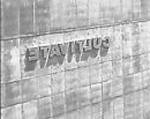
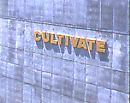
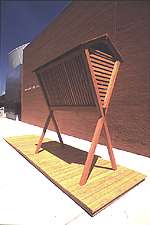
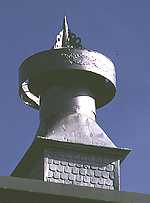
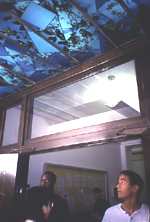
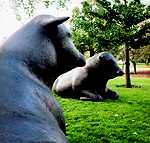
Public Art, Artist
and Content
David Allen
There are currently over two hundred and fifty public art programs in existence in this country. The majority are structured after the "percent for art" model that originated in Philadelphia in the late 1950’s. However, there are numerous other funding and administrative formats employed by cities, counties, states, transit agencies, colleges, and universities.
The practice of public art and its administration is anything but a mutually accepted discipline with recognized standards. It is a very broad field that has evolved and expanded in a rather free-for-all manner. One of the benefits of this lack of structure is that it has lead to a continuing reinterpretation of how artists work in our built world. This work has been labeled, often in hindsight, with a number of descriptive terms: stand alone, art in public places, site specific, site responsive, site generated, integrated, community based, civic, art and design, and new genre. If nothing else, the sheer number of terms is evidence that a lot has gone on in this field, and more will come.
While no "best practices" for commissioning public art currently exist, the first national public art organization, Public Art Network (www.artsusa.org/PAN/index.html), has taken on their creation as one of its goals. It is interesting that these standards haven’t been sorted out by now considering the hundreds of millions of commission dollars expended over the past two decades. One clue to their absence might be the fact that there are only a handful of college and university programs dedicated to teaching public art or its administration. While the number of artists working in the public realm has dramatically increased over the past two decades, it is still a practice that is largely misunderstood in academia. This may change as more colleges and universities develop public art programs for their own campuses.
There are several fundamental issues that should be considered by anyone interested in creating public art for land grant universities: why should institutions sponsor public art, and what are the responsibilities of sponsors and artists in this endeavor?
True Content
The answers most cited for "why public art" have to do with beautification, cultural enrichment, creating a unique sense of place, engaging communities in dialog, and fostering civic ownership. These are all good reasons, but they miss the essential and unique role of the artist in our world.
Today, at least in this country, a considerable part of who we are, and who we are becoming is now defined and shaped by commercial interests. Much of how we now spend our time, including recreational and leisure activities, is the result of carefully planned and edited messages in our urban landscape - on billboards, buildings, and street corners - that define quality of life. Collectively we pay attention to these messages, and have come to accept them as influential and even valid to our lives, even though we know not to mistake them for the truth. The purpose of commercial images is to sell, while the purpose of good architecture and landscape architecture is primarily function and beauty. And then there is public art, with a larger purpose, to convey "true content."
Sometimes with the complexities of our popular culture, these functions become confusing. Take the golden arches for example. Aside from how one might feel about the aesthetic merits of these sculptural forms, in this use their primary purpose was, and is, brand recognition, their function and beauty being secondary. As architecture, the purpose of the arch in St. Louis, an almost identical form, was function and beauty, any residual branding benefit for the community of St. Louis being secondary. But as a celebration of the "gateway" to Lewis and Clark’s west, Saarinen’s magnificent concept takes on the larger purpose of true content.
True content is the domain of science and humanities, including the arts. While not every historical recording is accurate, scientific theory correct, belief provable, or artistic expression a reflection of reality; the intent of these disciplines is to convey true content as the historian, philosopher, scientist, theologian, or artist sees it. Artists have been, and continue to be, key creators and chroniclers of cultures. We look to them for an honest attempt at truth.
This is why it is essential that more of our college and university institutions foster and support the work of public artists. As centers for education and experimentation, universities are in a unique position, more so than cities or other governmental bodies that commission public art, to support the search for true content.
As we move into this new century, we should remember that the environments that we build, whether they be cities or campuses, are not fictional theme parks, they are civic places, the free public realm. Just as citizens have rights and responsibilities, so do public institutions in the creation of these public places. Responsible communities need to attempt to balance the fiction of commercialism with the true content of the arts. To do this, we call in the specialist, the public artist.
The Public Artist
What is unique to the working process of the public artist? Public artists are responsible to an external client: the community and the commissioning agency acting on behalf of the public, while studio artists essentially serve as their own client.
Public art is rarely created in the vacuum of the artist’s studio in an inspired moment. It is most often created incrementally through an understanding of many factors: budget, schedule, feasibility, future maintenance, the site’s physical characteristics, its environs, and their use. The public artist may also consider historical, cultural, economical, political, societal, and behavioral information as well. This information is accumulated in many ways: through meetings with the commissioning agency and the project design consultants, one on one conversations with stakeholders and users, meetings with the public, research at local public and academic libraries, and so on.
The essential and defining gift that differentiates the artist from other design professionals is true content. Without this we have design. Or as one noted public artist puts it, "public art light." While good design is of great value, most projects are already crawling with design and engineering professionals, and we need to recognize the different and distinct role that artists play along side these other disciplines.
Public art, by its very nature, is collaboration, but whatever the process we use to commission it, that structure should never lose sight of the fact that we are after all, looking to create art, hopefully with true content.